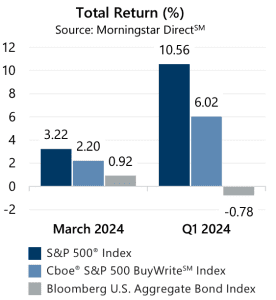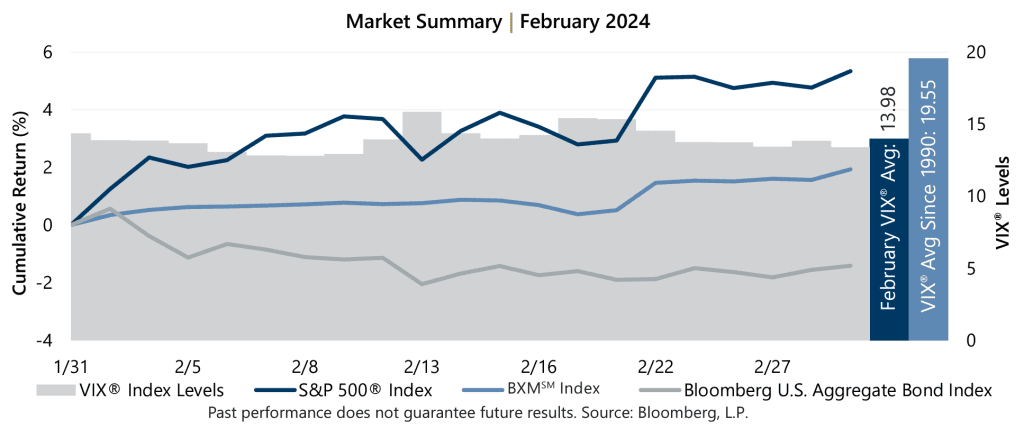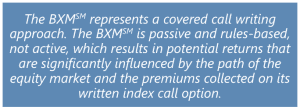 The equity market’s 10.56% rally during the first quarter of 2024 resulted in the S&P 500® Index reaching a new all-time high. The S&P 500® returned 1.68%, 5.34%, and 3.22% in January, February, and March, respectively. After a year-to-date maximum drawdown of just -1.68%, from the start of the year through January 4, the market persistently advanced during the quarter. The market was driven, in part, by enthusiasm surrounding AI-related technology and an ongoing optimism that the U.S. Federal Reserve will follow through with suggestions of multiple interest rate cuts during the remainder of 2024.
The equity market’s 10.56% rally during the first quarter of 2024 resulted in the S&P 500® Index reaching a new all-time high. The S&P 500® returned 1.68%, 5.34%, and 3.22% in January, February, and March, respectively. After a year-to-date maximum drawdown of just -1.68%, from the start of the year through January 4, the market persistently advanced during the quarter. The market was driven, in part, by enthusiasm surrounding AI-related technology and an ongoing optimism that the U.S. Federal Reserve will follow through with suggestions of multiple interest rate cuts during the remainder of 2024.
Macroeconomic data released during March showed continued resilience in the U.S. economy with stubborn inflation. The third estimate of Gross Domestic Product for the fourth quarter of 2023 showed an acceleration from the prior reading and outpaced the consensus estimate. The February Consumer Price Index released March 12 was higher than the previous reading and above consensus estimates. Corporate earnings reflected resilience, with fourth quarter aggregate operating earnings on track to climb 1.7% quarter-over-quarter and 8.4% year-over-year. With over 99% of S&P 500® Index companies reporting, nearly 79% met or exceeded analyst estimates.

Implied volatility, as measured by the Cboe® Volatility Index (the VIX®), averaged 13.71 in the first quarter. Consistent with its typical relationship, average implied volatility exceeded realized volatility, as measured by the standard deviation of daily returns for the S&P 500® Index, which was 10.97% for the quarter. The VIX® ended December at 12.45 before drifting to an intra-quarter low of 12.44 on January 11. The VIX® reached an intra-quarter high of 15.85 on February 13 and closed the quarter at 13.01.

 The Cboe® S&P 500 BuyWriteSM Index1 (the BXMSM) returned 6.02% in the first quarter of 2024 with returns of 1.77%, 1.93%, and 2.20% in January, February, and March, respectively, while collecting premiums of 1.55%, 1.50%, and 1.57% in each respective month. The premiums that the BXMSM collected as a percentage of its underlying value were insufficient to keep pace with the rapid advance of the S&P 500® Index. However, the remaining premium from writing its index call option contract in December offset losses during the brief market drawdown that started the year. With a return of -0.50%, the BXMSM provided 118 basis points of downside loss mitigation during the equity market decline from the start of the year through January 4. From January 4 through quarter-end, the BXMSM returned 6.55% relative to the S&P 500® Index return of 12.45%.
The Cboe® S&P 500 BuyWriteSM Index1 (the BXMSM) returned 6.02% in the first quarter of 2024 with returns of 1.77%, 1.93%, and 2.20% in January, February, and March, respectively, while collecting premiums of 1.55%, 1.50%, and 1.57% in each respective month. The premiums that the BXMSM collected as a percentage of its underlying value were insufficient to keep pace with the rapid advance of the S&P 500® Index. However, the remaining premium from writing its index call option contract in December offset losses during the brief market drawdown that started the year. With a return of -0.50%, the BXMSM provided 118 basis points of downside loss mitigation during the equity market decline from the start of the year through January 4. From January 4 through quarter-end, the BXMSM returned 6.55% relative to the S&P 500® Index return of 12.45%.
The Bloomberg U.S. Aggregate Bond Index returned -0.78% in the first quarter, with monthly returns of -0.27%, -1.41%, and 0.92% in January, February, and March, respectively. The yield on the 10-year U.S. Treasury Note (the 10-year) ended 2023 at 3.88% from which the yield would rise to an intra-quarter high of 4.32% in late February, and again in mid-March, before closing the first quarter at 4.20%. In a historical inversion that has persisted since July 5, 2022, the yield on the 2-year U.S. Treasury Note exceeded that of the 10-year throughout the first quarter.
1The BXMSM is a passive total return index designed to track the performance of a hypothetical buy-write strategy on the S&P 500® Index. The construction methodology of the index includes buying an equity portfolio replicating the holdings of the S&P 500® Index and selling a single one-month S&P 500® Index call option with a strike price approximately at-the-money each month on the Friday of the standard index-option expiration cycle and holding that position until the next expiration.
Sources: Morningstar DirectSM, Bloomberg, L.P. Performance data shown represents past performance and is no guarantee of, and not necessarily indicative of, future results.
For more information and access to additional insights from Gateway Investment Advisers, LLC, please visit www.gia.com.
